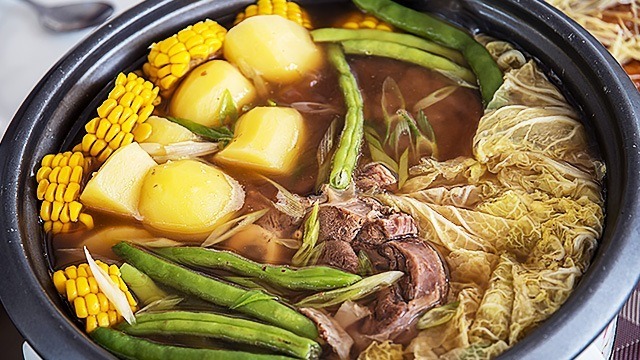Genuine Filipino Food Recipes to Attempt at Home
Discovering genuine Filipino food dishes offers a possibility to value the complex flavors and social importance behind each meal. Using fresh, regional active ingredients is crucial, as is accepting common dining-- a hallmark of Filipino culture.
Popular Filipino Dishes
Filipino cuisine boasts an abundant tapestry of flavors and traditions, with over a dozen iconic recipes that highlight the nation's diverse social influences. Among the most widely known recipes is Adobo, a savory stew commonly made with hen or pork, marinated in vinegar, soy sauce, garlic, and seasonings. Its tasty taste profile makes it a staple in Filipino households.
One more precious recipe is Sinigang, a sour soup commonly made with tamarind, tomatoes, and numerous veggies. This meal can feature pork, shrimp, or fish, and its revitalizing preference is excellent for warm environments. For those with a pleasant tooth, Leche Flan-- a luscious caramel custard-- functions as a preferred treat, showcasing the Filipino penchant for rich, wonderful flavors.
Kare-Kare, a passionate oxtail stew with a thick peanut sauce, together with the renowned lumpia, or springtime rolls, further exemplify the variety located in Filipino cuisine. Each recipe not only provides distinct preferences yet additionally tells a story of local components and historic influences, making Filipino food a vivid representation of its society and heritage.
Important Active Ingredients for Filipino Food Preparation
The essence of Filipino cooking lies in its necessary active ingredients, which act as the structure for the nation's beloved recipes. A variety of tastes and structures collaborated, showcasing the diverse cultural influences that shape Filipino food.
Key components include rice, the staple that accompanies almost every dish, symbolizing nutrition and neighborhood. Soy sauce, vinegar, and fish sauce (patis) are essential for seasoning, imparting umami and depth to dishes. Fresh natural herbs like cilantro and basil add aromatic freshness, while garlic, onion, and ginger give a robust flavor base.
Healthy protein sources such as pork, hen, and fish and shellfish are central to numerous recipes, commonly marinaded to boost taste. Veggies like eggplant, bitter melon, and environment-friendly beans add essential nutrients and equilibrium - Filipino food recipes. Coconut milk is one more substantial active ingredient, providing creaminess and a refined sweetness to various stews and treats
Lastly, calamansi, a citrus fruit, offers a revitalizing flavor that elevates meals and beverages alike. With each other, these components develop the lively and rich tapestry of tastes that define Filipino cuisine, making it both comforting and unique. Understanding these basics is essential for any person seeking to duplicate authentic Filipino recipes my response at home.
Step-by-Step Dish Guide
:max_bytes(150000):strip_icc()/Filipino-Features-Soups-and-Stews-1e81ba12ce10481caf3ff58981c347ab.jpg)
Beginning by preparing your components. For Adobo, slice the meat into consistent items and season it in soy sauce, vinegar, garlic, and bay leaves for at least half an hour. Next off, warmth oil in a frying pan and sauté the garlic and onions until fragrant, then include the marinated meat, permitting it to brown evenly.
For Sinigang, begin by boiling water in a pot and including your selection of meat. When tender, incorporate tamarind paste or fresh tamarind for that trademark sour taste. Follow with veggies like radish and kangkong, cooking till just tender.

Tips for Authentic Flavor
Often, achieving genuine taste in Filipino dishes pivots on the mindful choice and treatment of active ingredients. Beginning with fresh, high-grade produce, as the vibrancy of vegetables and herbs dramatically improves the dish's overall preference. Staples like garlic, onions, and ginger develop the fragrant structure for lots of dishes; utilizing them in proper proportions is critical.
Choosing the best protein is equally important. As an example, typical adobo typically uses chicken or pork, marinaded to soak up the marinate's full taste. Additionally, consider sourcing in your area created or local ingredients, as they can offer credibility that store-bought alternatives do not have.
Cooking techniques likewise play an important role. Slow-cooking techniques, such as braising or stewing, permit tastes to blend perfectly, while frying can include a rewarding texture. Do not find here ignore flavoring; utilizing salt, fish sauce, or soy sauce at the appropriate moments can raise a dish considerably.
Serving and Enjoying Filipino Food
Culinary experiences are improved when Filipino food is served with attention to custom and neighborhood. The method of sharing dishes is you could try this out main to Filipino society, signifying unity and friendliness. When serving Filipino meals, think about using traditional serveware, such as clay pots or bamboo baskets, which boost the credibility of the experience.
Usually, Filipino dishes are enjoyed family-style, with a variety of meals placed at the facility of the table. This public technique motivates communication and allows guests to example various flavors. A well-curated spread may consist of staples like adobo, sinigang, and lumpia, enhanced by rice, which is a basic component of every dish.
Accompanying the food with conventional spices, such as soy sauce, vinegar, or chili paste, can elevate the dining experience, welcoming restaurants to customize their plates to their preferences. In addition, integrating local drinks, like calamansi juice or tuba, can enhance the general taste profile.
Conclusion
:max_bytes(150000):strip_icc()/Beef-Stir-Fry-with-Snow-Peas-2000-eaa56c8a960f447c816c9de642a21c70.jpg)